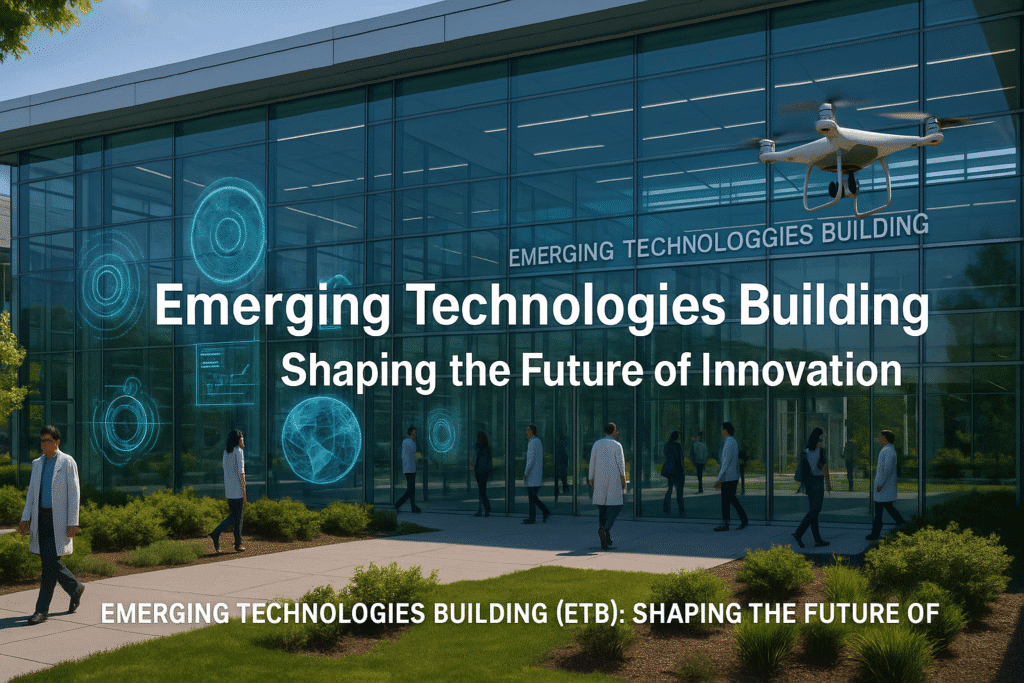
The Emerging Technologies Building ETB is a cutting-edge facility aimed at fostering research, education, and entrepreneurship in new spheres of science and technology. The buildings harmonize specialized labs, high-tech classrooms, maker spaces and collaboration areas under the same roof. Emerging technologies building etb have students, faculty and industry partners working together in incredibly interesting areas of the latest technologies — from artificial intelligence and robotics to biotechnology and sustainable energy. The intention is to bring together “the best brains in a range of fields for hands-on cooperation in the same physical location” (in the words of one university) to spur innovation in health, security, manufacturing and more. tamu. edu).Emerging technologies building etb are cropping up across the country on university campuses and in tech parks regional drivers of the innovation economy. They change how science and industry collaborate, delivering the infrastructure that will produce breakthroughs and build fresh start-up companies
What is an Emerging Technologies Building (ETB)?
ETB: Innovation on a Foundation of Research The ETB is a state-of-the-art, next-generation research and collaboration facility. Think of it as a type of campus building (one usually related to a college or research institution) where you find the stuff furthers tech development of the high-end type. Unlike conventional labs, which concentrate heavily by discipline, emerging technologies building etb are multi-disciplinary: under one roof, the building may house engineering, computer science, biotechnology and even design or business programs. Such closeness breeds collaboration, with engineers able to run experiments side-by-side with biologists and computer scientists, and thus creating new ideas and projects from scratch.
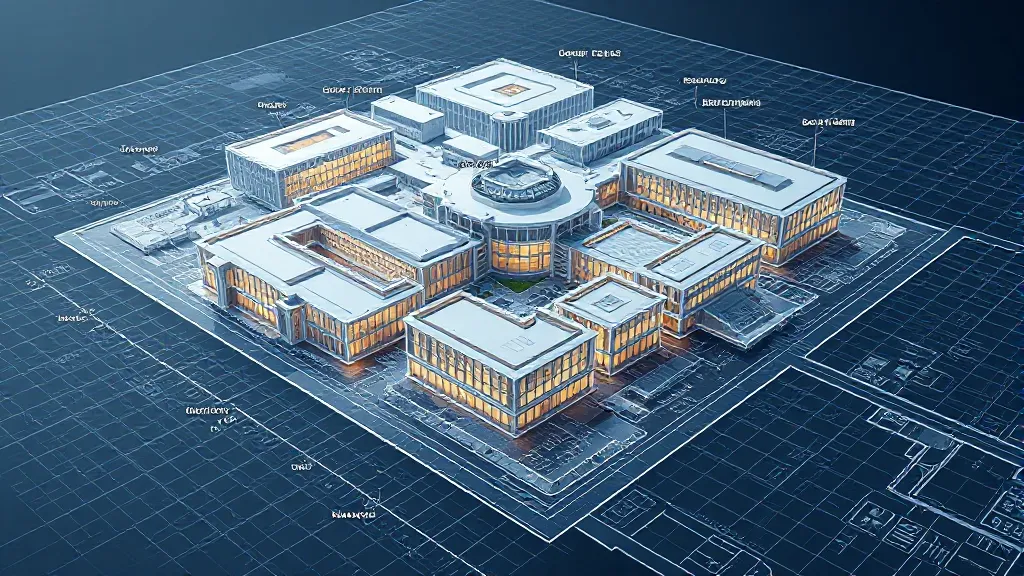
For example, Texas A&M University’s ETB houses biomedical and industrial engineering departments alongside computing and geoscience labs (engineering.tamu.edu). By design, these facilities include everything from high-performance computing clusters and AI labs to wet labs for biomedicine. The TAMU building even contains an underwater robotics lab and a large-scale visualization theater (engineering.tamu.edu). In short, an emerging technologies building etb is more than just a new building – it’s an integrated ecosystem for emerging science and technology, engineered to support both academic research and real-world innovation.
Key Features of an ETB
Emerging Technologies Buildings share several common features that distinguish them from standard campus buildings. They often include:
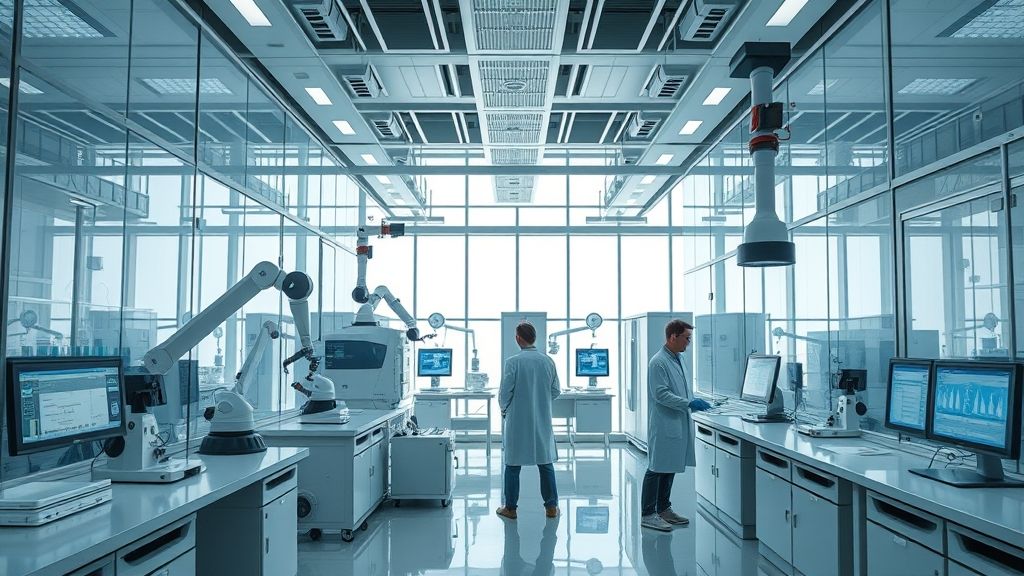
Flexible High-Tech Laboratories: Modern wet-bench labs (with fume hoods for experiments in biomaterials, biomechanics and biotechnology) and dry-tech labs (for electronics, robotics, optics, etc.) are standard (engineering.tamu.edu). These labs are built to be reconfigurable, so equipment can be added or moved as research needs evolve (sc-arch.com).
Advanced Computing and Visualization Facilities: Large data analysis and machine learning projects require powerful computers. ETBs typically have 24/7 computing labs, high-performance servers, and even immersive visualization rooms for 3D modeling or virtual reality demonstrations (engineering.tamu.edu).
Collaborative Workspaces: Open atriums, maker-spaces, and flexible meeting rooms encourage teamwork. For example, the TAMU ETB features a three-story atrium designed for events and research showcases (engineering.tamu.edu). Such spaces let students and researchers present their work to peers and industry visitors.
Specialized Testing Facilities: Some ETBs include unique labs tailored to their focus area. As one example, Texas A&M’s building has a submersible underwater lab for testing autonomous vehicles in a controlled tank (engineering.tamu.edu). Others might have cleanrooms for semiconductor research or anechoic chambers for advanced sensors.
Teaching and Learning Infrastructure: To bridge education with research, ETBs usually include modern classrooms and lecture halls equipped with the latest audio-visual gear. TAMU’s ETB, for instance, has nine classrooms and two large lecture halls optimized for high-tech teaching (engineering.tamu.edu).
Industry Collaboration Zones: Many ETBs feature dedicated areas where industry partners can collaborate. These may include offices for corporate researchers, demo rooms with multi-screen displays, or co-working labs shared by startups and university teams (sc-arch.com).
Sustainability and Adaptability: New ETBs often follow green building standards (LEED, etc.) and are designed for long-term adaptability. In fact, architects note that the TAMU building “provides an environment that cultivates emerging research through flexible, sustainable, and innovative strategies” (sc-arch.com).
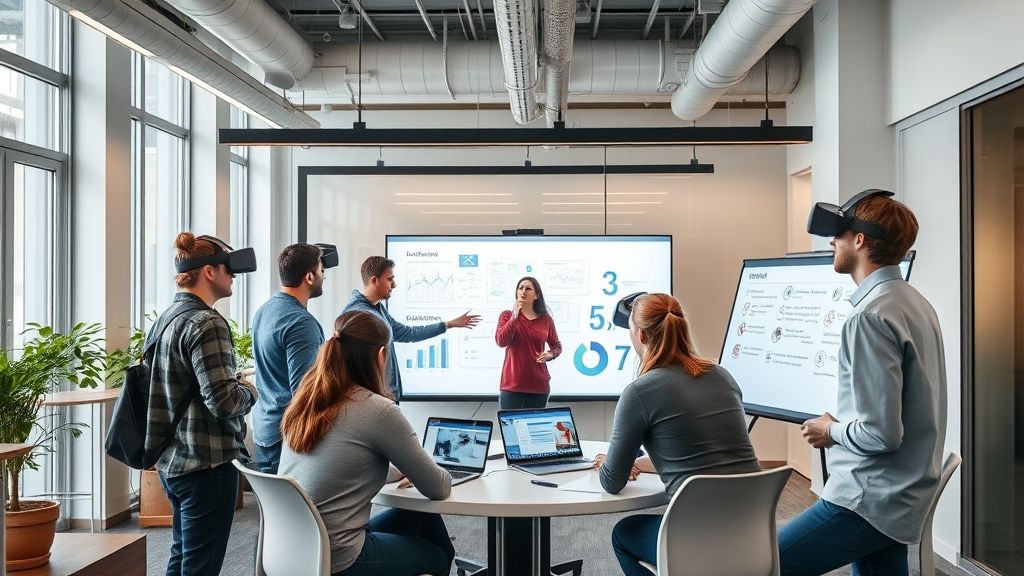
Overall, the hallmark of an ETB is integration: combining classrooms, labs, offices and collaborative spaces under one roof to jump-start innovation. This tight integration contrasts with older setups where engineering, science and business were siloed. Now, an idea for a new biotech device can grow from a class project to a research experiment to a startup pitch all within the same facility.
Interdisciplinary Research and Innovation
Emerging Technologies Buildings drive interdisciplinary research by facilitating projects that span multiple fields. Inside these hubs, a data scientist might work with a medical researcher to develop AI for healthcare, or a materials engineer might collaborate with oceanographers to design new underwater drones. The physical proximity of diverse labs and experts enables these cross-cutting projects.
For example, many ETBs focus on hot fields like:
- Artificial Intelligence & Machine Learning: Teams build AI models for everything from self-driving vehicles to smart manufacturing. They leverage GPU clusters and big data analytics suites housed in the ETB.
- Robotics & Automation: Roboticists develop autonomous systems – whether industrial robots on manufacturing floors or service robots for daily tasks. (For instance, one robotics lab even sets up a mock kitchen inside the lab so service bots can learn to navigate real-world home environments (commons.wikimedia.org).)
- Biotechnology & Biomedical Engineering: In wet labs, researchers experiment with advanced biomaterials, gene therapies, medical imaging, and other life-science innovations.
- Cybersecurity & Networks: As emerging tech also brings new risks, ETBs often include secure labs for testing cryptography, networks, and privacy-preserving computing.
- Clean Tech & Sustainability: Projects in renewable energy, battery tech, and climate modeling are common, tying technical work to pressing global challenges.
- Advanced Manufacturing & Materials: With equipment like 3D printers and nano-fabrication stations, ETBs support designing new materials and microchips.
- Human-Computer Interaction and VR/AR: Some ETBs include virtual/augmented reality labs to explore next-gen interfaces and immersive simulations.
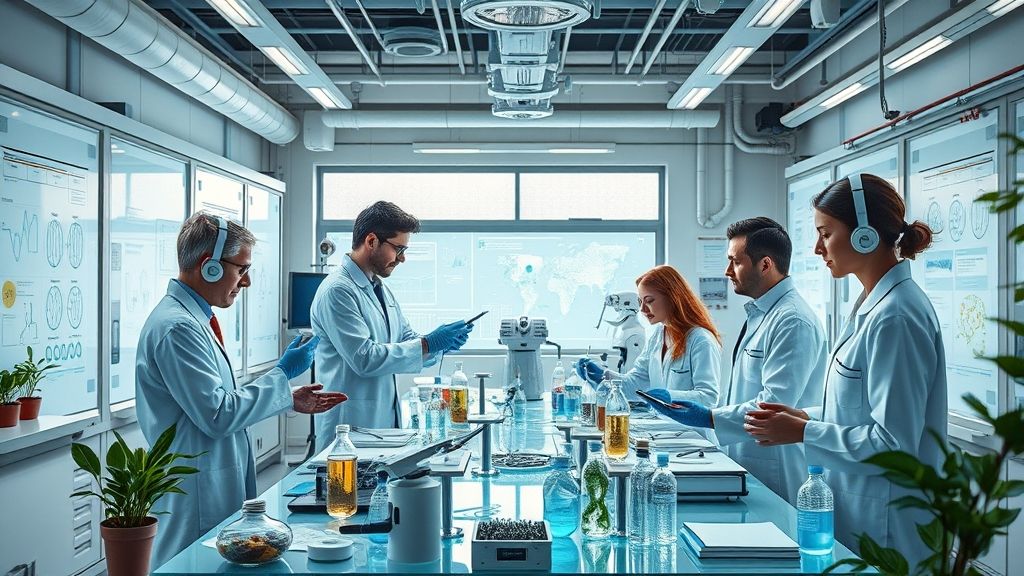
By housing all these expertise areas together, ETBs spark synergy. A team building a surgical robot, for example, can more easily collaborate with computing experts on its vision system and with design students on the user interface. The shared facilities also allow “demonstration labs” with multi-screen displays or VR, where researchers can showcase prototypes to sponsors or public audiences (sc-arch.com). This kind of setup accelerates learning cycles: instead of going back and forth between separate buildings, innovators try ideas in real time together.
In addition, many ETBs emphasize partnership projects. For example, industrial partners or government agencies may fund a lab inside the building, bringing real-world problems to students and faculty. Some ETBs even have adjacent incubators or startup centers, where research ideas can spin off into new companies quickly. The presence of corporate affiliates on-site (common areas, joint labs) bridges academia and industry seamlessly.
Fostering Startups and Collaboration
Emerging technologies building etb play a key role as innovation incubators. By design, they encourage entrepreneurial ventures and industry ties:
- Startup Incubation: Many ETBs include space for student- or faculty-led startups. These might be small offices or co-working labs where budding entrepreneurs get access to the building’s labs and equipment. For instance, a team developing a new medical device could have a lab bench in the ETB to build prototypes, along with a meeting room to meet with advisors.
- Mentorship and Networking: ETBs often host workshops, hackathons, and pitch competitions in their atriums or auditoriums. This puts students and researchers in front of investors, industry mentors, and potential customers. The architecture – open spaces with demo areas – is explicitly designed to showcase new ideas (sc-arch.com).
- Industry Consortia: Companies might form consortia that share a lab in the ETB. For example, a handful of manufacturing firms could jointly fund an advanced robotics lab and then recruit graduate students to research automation solutions. The proximity helps accelerate tech transfer back to those companies.
- Public-Private Partnerships: Government agencies sometimes establish programs within ETBs. An ETB might host NSF-funded research projects or DOD-sponsored labs, linking national R&D priorities (like autonomous systems or biotech) directly into the university environment.

Together, these elements make ETBs vibrant collaboration ecosystems. Instead of research happening in isolation, a solution can be prototyped, tested, and iterated with direct input from all stakeholders. The result is a shorter path from lab discovery to market deployment. In practical terms, this means more university spin-off companies and patents emerging from these hubs.
Benefits to Students and Researchers
For students and academics, Emerging Technologies Buildings offer unique learning and career advantages:
- Hands-On Training: Access to professional-grade labs and equipment means students graduate with practical experience. They don’t just learn theory; they run real experiments in biotech labs, code in AI clusters, and build prototypes in fabrication shops.
- Interdisciplinary Education: ETBs often enable cross-listed courses or joint programs. A biology student might take a workshop in machine learning, or an engineering class might include clinicians from a medical school in the ETB. This broad perspective is invaluable in today’s complex tech fields.
- Research Opportunities: Graduate students can tap into funded projects inside the ETB. Having top-notch facilities on campus makes it easier to attract research grants. Faculty can recruit interdisciplinary teams across departments by simply inviting colleagues to the ETB.
- Career Preparation: By working on cutting-edge projects, students build portfolios that attract tech employers. Many ETBs have career events and internship programs with local tech firms. A study area with 24/7 access to computing resources also means ambitious students can work odd hours, just like startup culture.
- Innovation Culture: The ethos of an ETB is entrepreneurial and experimental. This culture encourages students to think creatively, take initiative, and launch ventures. Entrepreneurship certificate programs or engineering honors programs are often embedded within the ETB environment, linking coursework with innovation practice.
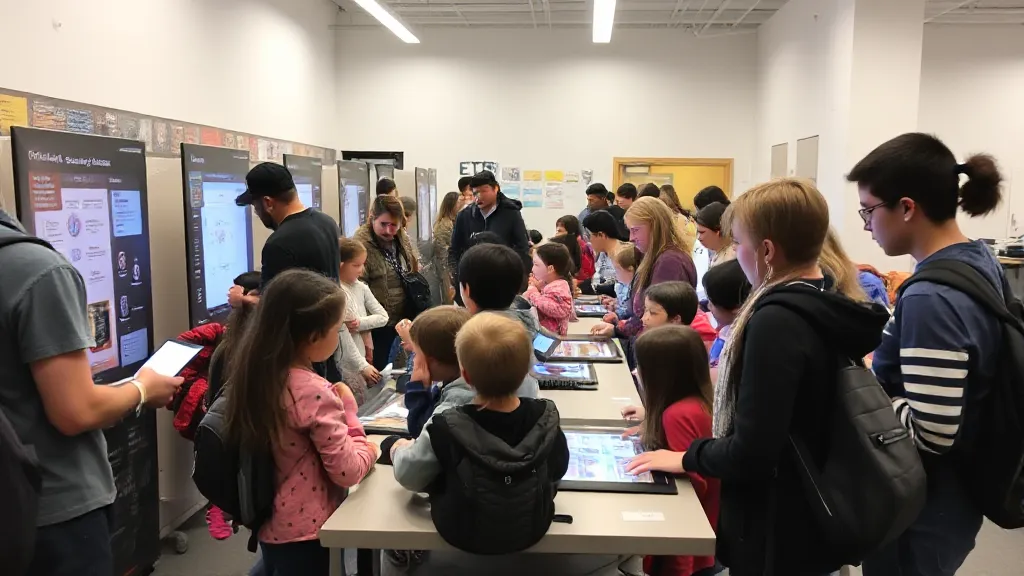
In summary, ETBs serve as education accelerators. They create a pipeline where students learn by doing, working on real-world problems from their first year on campus. Post-graduation, these students are more likely to enter STEM careers equipped with skills to innovate immediately.
Impact on Industry and the Public Sector
The benefits of Emerging Technologies Buildings ripple beyond campus:
- Industry R&D Boost: Local and national companies gain from a trained workforce and technology partnerships. Engineers who trained in an ETB know the latest tools and methodologies, reducing on-boarding time. Companies can also sponsor student projects (essentially outsourcing early R&D) at lower cost. In return, they often get first-look at new inventions or hire graduates trained on their specific needs.
- Economic Development: A region with one or more ETBs becomes more attractive for tech investment. As place-based innovation hubs, ETBs can anchor tech corridors or “innovation districts.” For example, a city with a strong ETB could attract startup offices and venture capital, knowing there is a continuous influx of ideas and talent.
- Solving Public Challenges: ETBs often align research with public priorities: think renewable energy to fight climate change, medical devices to improve healthcare, or autonomous vehicles for safer transportation. Public-sector agencies (NIH, DOE, DoD, NSF, etc.) partner with ETBs to tackle these issues. The interdisciplinary approach is especially valued for complex problems that span technology and social impact.
- Educational Outreach: Many ETBs include STEM outreach programs. High school and community college students might visit to see demonstrations, or teachers might train on new tech tools. By serving as a portal to cutting-edge science, ETBs help grow the future STEM pipeline and promote public science literacy.
- Building National Capacity: On a broader scale, ETBs support U.S. strategic interests. For instance, to maintain leadership in AI and quantum computing, the government relies on university labs to innovate and train experts. ETBs effectively multiply the impact of such federal priorities. As the White House notes, recent legislation like the CHIPS and Science Act provides “historic public investments in STEM education and workforce development” (bidenwhitehouse.archives.gov). ETBs embody these investments by physically expanding our capacity to educate talent and generate new tech.
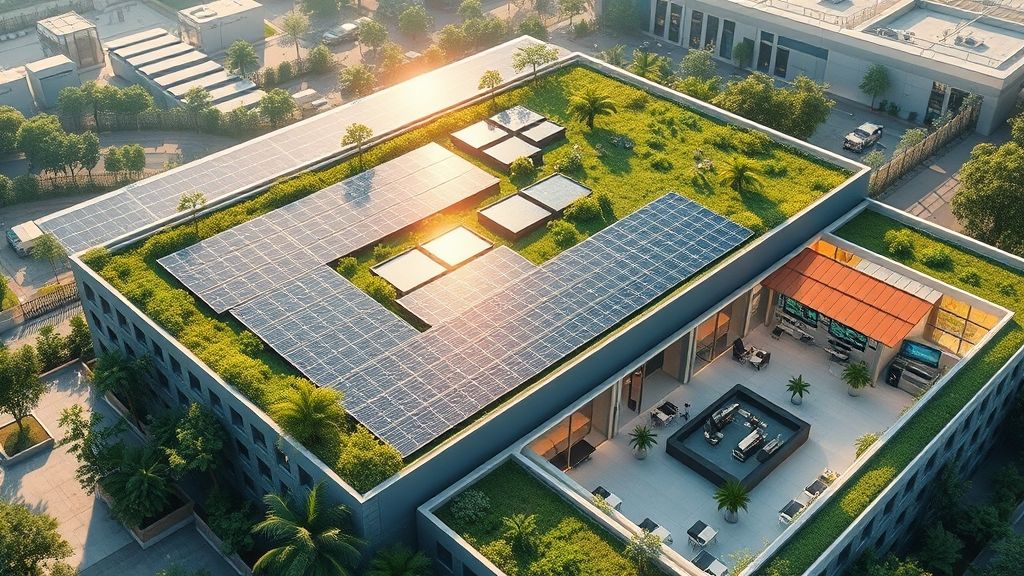
By acting as a bridge between academia, industry, and government, ETBs strengthen the innovation ecosystem. Corporations partner with ETBs to stay competitive, while the public sector sees accelerated solutions to grand challenges. Ultimately, this synergy leads to more jobs, higher-quality products, and national security benefits – just as the EDA’s Tech Hubs initiative envisions when it funds consortia of academic and industry players to drive “regional growth” in future technologies (eda.gov).
Integration with U.S. Economic and Educational Strategies
Emerging Technologies Buildings dovetail with broader U.S. strategies for science and education. In recent years, federal policy has increasingly emphasized STEM infrastructure and partnerships:
- STEM Education Initiatives: The White House’s 2024 Federal STEM Education Plan highlights partnerships, innovation spaces, and workforce development as key pillars (bidenwhitehouse.archives.gov). ETBs directly address these pillars by creating new learning environments and industry-academic ecosystems. Universities with ETBs are essentially enacting the plan’s vision at the campus level.
- Funding and Policy: Major laws like the CHIPS and Science Act of 2022 and the COMPETES Act have directed billions toward R&D and education. A notable goal is to build resilience in tech supply chains and talent pipelines. By housing advanced chip labs or AI centers, ETBs can absorb some of this funding and translate it into tangible breakthroughs and new STEM graduates.
- Regional Innovation Hubs: The federal Economic Development Administration’s Tech Hubs program (launched in 2021) invests in just this kind of clustering of academic, corporate, and civic players (eda.gov). ETBs often serve as anchors for Tech Hubs at the local level. For example, a university ETB might partner with nearby community colleges and industry to apply for Tech Hubs grants, aligning with the EDA’s mission to “strengthen U.S. economic and national security” through new technology industries (eda.gov).
- Workforce Pipeline Goals: Congress and the Executive branch have repeatedly stressed closing the STEM skills gap. ETBs are a practical tool for this: they expand lab-based undergraduate research, which studies show boosts retention in STEM majors. Graduate programs tied to ETBs tend to produce researchers who stay in high-tech fields. In effect, each ETB can be seen as an investment in the next generation of engineers and scientists.
- University-Industry Collaboration Models: Many federal and state agencies promote university–industry consortia (through NSF Industry-University Cooperative Research Centers, Manufacturing USA institutes, etc.). ETBs often become the physical venue for these partnerships. By having corporate labs or sponsored projects on-site, ETBs align with policy incentives for translational research and tech transfer.
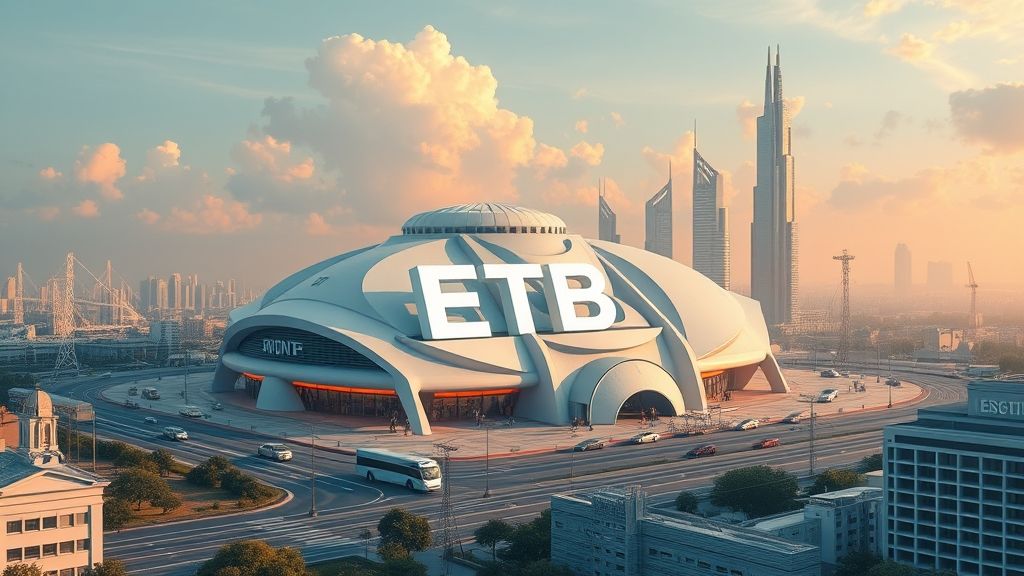
In summary, Emerging Technologies Buildings are the on-the-ground implementation of national innovation strategy. They leverage state and federal support to bring theory into practice, growing both the economy and the talent pool. As one policy maker put it, maintaining U.S. leadership in tech “requires a strong workforce” and immersive environments for research (bidenwhitehouse.archives.gov) – exactly what ETBs provide.
Conclusion
Emerging Technologies Buildings represent a bold model for the future of American innovation. These purpose-built hubs break down silos between disciplines and sectors, creating a fertile ground for the next big ideas. By combining advanced labs, collaborative spaces, and educational programs, ETBs turbocharge the development of AI, robotics, biotech and more. Students gain hands-on experience and entrepreneurial drive, while researchers benefit from immediate industry feedback. Corporations and government agencies, in turn, find ready partners to tackle complex challenges.

As demand grows for homegrown tech solutions, ETBs will continue to shape science and industry. They align perfectly with U.S. goals in STEM education and economic competitiveness. Whether it’s discovering a new medical therapy, designing smarter clean energy systems, or spinning up a groundbreaking startup, the Emerging Technologies Building is where those futures begin. It’s more than a building – it’s an engine that powers innovation in America.
Also read about A Detailed Guide for The Ethics of AI









Emerging Technologies Building (ETB): Shaping the Future of Innovation – Future Bit
acfffqygcyc
cfffqygcyc http://www.g5n8x6u85o6y6bhusui0l7w6724v9s32s.org/
[url=http://www.g5n8x6u85o6y6bhusui0l7w6724v9s32s.org/]ucfffqygcyc[/url]
0lv6t8
oa132m
Air Source Processor
Manufacturers
Solar Power Bank
Forklift Lithium Battery
Raydafon High Torque Gearbox Reducer Worm Planetary Spur Helical Bevel Motor Gear Box
cheap louis vuitton sneakers for women
agricultural land leveling equipment
pstz.org.pl
cheap louis vuitton speedy
Elastomeric Coupling
ISO DIN ANSI Standard Heavy Duty Series Cottered Type Roller Chains
cheap louis vuitton suitcase
cheap louis vuitton suit hanging bag
Raydafon Iron Steel Alloy Conveyor Industrial Galvanized Roller Chains
cheap louis vuitton stuff
Double Pitch Transmission Roller Chains With A-1 SA-1 K-1 SK-1 Attachment
Manufacturer
Commercial Lighting Fixtures
cheap louis vuitton replicated handbags
Patio Furniture Manufacturers
cheap louis vuitton replica shoes
1:1 1.5:1 2:1 2.5:1 3:1 Ratio T Series Spiral Bevel Gear Units Reducer Worm Agricultural Gearbox Reducers
microbait.pl
cheap louis vuitton sale
Overhead Forging Detachable Chains Trolley Attachment Drop Forged Rivet-less Side Link Pusher Dog Conveyor Chain
Manufacturers
cheap louis vuitton replica wallets
cheap louis vuitton rolling luggage
Agricultural Gearbox for Flail Mower PTO Drive Shaft Steel Straight Spline Drive Gear High Precision OEM
Lamp Cap
Mechanical Seal for Flygt Original Pump Seal
YOX Series Oil Filling Fluid Coupler Hydraulic Quick Coupling
Caster Swivel Wheel
cheap louis vuitton travel men totes
http://www.starymlyn.info
Raydafon Pintle Chain
Sell Packaging
Raydafon Agriculture Chain
Raydafon Leaf Chain
Raydafon Engineering Chains
Supplier
Pilates Toe Socks
Raydafon Driving Chains
Ionic Surfactant
cheap louis vuitton travel bags
cheap louis vuitton us
cheap louis vuitton travel luggage
cheap louis vuitton uk
dcxncu
Graphit Paper
cheap louis vuitton purses replica
AH Series Plate – Fin Hydraulic Aluminum Oil Coolers
Casement Windows
cheap louis vuitton purses real louis vuitton purses
cheap louis vuitton purses handbags
Solar Powered Battery Charger
cheap louis vuitton purses louis vuitton handbags
Special Conveyor U Type Cranked Plate Attachment Chain Used for Printer
Suppliers
cheap louis vuitton purses real louis vuitton purs
AL Series Hot Exchange Plate-Fin Heat Sink Hydraulic Aluminum Oil Coolers
Lvt Tile Flooring
Raydafon MSAL Series Aluminum Alloy Mini Pneumatic Cylinder
borisevo.ru
Customized Steel Steel Worm Gear and Brass Wheel
ac electric motor
cheap neverfull pm
cheap mens louis vuitton shoes
Chocolate machine
Metal Stamping
Used for Flygt Pump Cartridge Seal Mechanical Seal
OEM Acceptable GT Series Pneumatic Boosting Cylinder
Led Linear Light
jdih.enrekangkab.go.id
cheap mens louis vuitton wallet
Intermediates
Industrial Rubber V-belt Timing Endless Conveyor Belt
cheap neverfull louis vuitton handbags
cheap never full lv bags outlet
4103 Pintle Chains
Spline Shaft 5 Axis Cnc Machining Process and Milling Parts Custom OEM Billet Bolt-on slip Stub Shaft
cheap lv belt
Gate Valve Parts
China
9142722 Tractor Parts Engine Starter Motor
cheap lv belt for men online
Flat Table Top Engineering Plastic Straight Run Flat-top Conveyor Chains
cheap lv belts
cheap lv bags usa
Nylon 66 Filament Yarn
Feed Mixer Gearbox
Side Middle Guide Industrial Conveyor Silent Chain
Manufacturers
Two-way 3-stage Mini Hydraulic Cylinders
Cnc Machine Working
cheap lv bags with papers
Green Energy
Plastic Link Food Industry Conveyor Components Flat Top Chain MULTI-FLEX Conveyor Chains
Bespoke Lighting
Standard Flexible Torque Limiter TL Torque Limiter TL200 TL250 TL350 TL500 TL700
cheap replica louis vuitton speedy
Cast Iron Chains CC600 Conveyor Chain Steel Chains
cheap replica louis vuitton purses
cnc router milling machine
Shrink Label
cheap replica louis vuitton purses wholesale
Water Purifier
cheap replica louis vuitton shoes
Super Sinus Spring Multiple Springs Rotating M7N M74 Chemineer Chemical Plain Shafts Pump Mechanical Seal
cheap replica louis vuitton suitcase
DIN ANSI ISO BS JS Standard Palm Oil Mills Conveyor Roller Chain with EXTENDED PIN Hollow Pin Palm Chains
Raydafon 9516653 Farm Tractors Parts URSUS and ZETOR Alternator
2GT 3GT T2.5 T5 T10 AT5 AT10 Xl Aluminum Bore 5mm Fit Timing Belt Pulley
cheap louis vuitton shoes men
cheap louis vuitton shoes replica
cheap louis vuitton shoes from china
cheap louis vuitton shoes free shipping
Pvc Cladding Panels
Electrotherapy Machine
Shaft-hub Locking Device for Connecting Hubs and Shafts with High Torque Transmission Locking Assembly
Pearl Wedding Dress Fabrics
Dock Boat
cheap louis vuitton shoes online
Furniture Stamping Parts
TypeF FB FBW FTK FT FBC FBF FW FK FBM Automotive Cooling Pumps Mechanical Seal
W K Type Taper Bore Weld-on Hubs
cheap replica lv bags
Executive Office Furniture
Single-Sided Rigid Pcb
cheap replica louis vuitton wallets
Laser Part Marking Machine
cheap replica lv bag for sale
Axle Shaft Coupling (Automotive/Industrial)
Mobile Printers
cheap replica lv bags from china
Elevator Automatic Sliding Gate Helical Straight Pinion M3 M5 M8 Wheel and Gear Rack
Top Quality Mechanical Transmission Spiral Bevel Gear
cheap replica lv cabas
Snow Sweeper Lawn Mower Assembly Standard Size Parts OEM Pulley Sheave
Solar Mounting
Piston Type Welded Hydraulic Steering Cylinder
ISO 4540 RATING 8-9 ASTM B 117 Customized Hard Chromium Plated Bar
Mig Co2 Welding Machine
Table Top Side Flex Side-flex Engineering Chains With Attachment Tap Plastic Sideflex Flat-top Chains
Commercial Glass Doors
Wpc Panel
cheap lv cross over bags in china
Waterproof Toggle Switch
cheap lv duffle bag
cheap lv coin pouch
cheap lv diaper bag
Outdoor Conditions Corrosion Resistant Conveyor Chains Nickel-plated Chains Zinc-plated Roller Chains
Hydraulic Power Unit
Excavator Engine Parts
cheap lv cross body bags
Metallurgical Industry Automobile Manufacture Piggyback HA HB HC Attachment Conveyor Skid Chains Large Pitch Heavy Loading Chain
Rotex Couplings
Good Price Gearbox Series P Reduce Gearbox for Bale Wrappers Bale Rotation in Winding bar Connect a Hydraulic Motor
Polished Chrome Handle
Raydafon Hydraulic Components Radial Spherical Plain Bearing GF..DO Rod Ends
Waterproof Led Screen
cheap louis vuitton outlet
cheap louis vuitton outlet handbags
cheap louis vuitton online
cheap louis vuitton out let
cheap louis vuitton outlet online
Rotary Cultivators Gearbox Agricultural Gearbox 90 Degree Farm Pto Right Angle Tractor Slasher Rotary Tiller Pga Feeder Mixer Ea
09063 Sugar Mill Chain Sugar Industrial Chains C2630
Metal with Mixture PCB
Shrink Label
China
GIICLZ Type Drum Gear Coupling
Excavator Cabin
cheap louis vuitton bedding
cheap louis vuitton bags with free shipping
cheap louis vuitton bandana
Tire Shredding
Raydafon ISO ANSI DIN Single Double Triple Strand Conveyor Roller Chain
Self Lubrication Transmissions Chains Self-lubrication Roller Chain
cheap louis vuitton belt
Industrial Rubber Belt Power Transmission V-Belt
Wound Products
Eco Reusable Bags
cheap louis vuitton bandanas
Carbon and Stainless Steel Roller Chain Sprockets with High Quality
Manufacturers
Very well written story. It will be helpful to everyone who utilizes it, including me. Keep up the good work – i will definitely read more posts.
American Standard ANSI Short Pitch Heavy Duty Series Roller Chains
cheap replica louis vuitton handbags in china
Manufacturers
cheap replica louis vuitton handbags in usa
cheap replica louis vuitton luggage sets
Hard Chromium Plated Shaft
cheap replica louis vuitton handbags
Supply the Regular Overhead Roller Chain Conveyor X678 Drop Forged Side Link Pusher Dog Drop Forged Side Link Pusher Dog
Pp Geotextile
Raydafon Triple Speed Chain Double Plus Speed Chain
http://www.isotop.com.br
Anal Training kit
Hanging Car Air Freshener
Leather Canvas Shoes
Raydafon Factory Supplier Excavator Large Drive Roller Chain and Sprocket Wheel
cheap replica louis vuitton luggage
Door Access Control
Raydafon Japan Standard Sprockets
Personalized Christmas Socks
cheap louis vuitton purse large
Raydafon V belt Pulley
cheap louis vuitton purse
Android Tablet
cheap louis vuitton products
Raydafon Timing belt Pulley
Electric Trucks
cheap louis vuitton pouch for men
Raydafon Sheave
RC Quadcopter
Raydafon Pulley&Sheave
http://www.zolybeauty.nl
cheap louis vuitton purse for sale
tcgxt2
1oxos7
Two-way 3-stage Mini Hydraulic Cylinders
9142722 Tractor Parts Engine Starter Motor
Flat Table Top Engineering Plastic Straight Run Flat-top Conveyor Chains
cheap louis vuitton bags in philippines
cheap louis vuitton bags in the philippines
jdih.enrekangkab.go.id
cheap louis vuitton bags in usa
cheap louis vuitton bags in toronto
Used Hydraulic Cylinder for Sale
Side Middle Guide Industrial Conveyor Silent Chain
cheap louis vuitton bags in paris
8oy2fh
cheap louis vuitton handbags outlet online
China
cheap louis vuitton handbags outlet
Aluminium Alloy HTD 2M 3M 5M 40T Timing Belt Pulleys 40 Teeth 6 8 10 12 14 15 16 17 19 20mm
Cast Resin Bus Duct
Nitrogen Generator
Dump Truck Double Acting Telescopic Hydraulic Cylinders
Gear Box Planetary Gear Speed Reducer
cheap louis vuitton handbags paypal
cheap louis vuitton handbags replica
http://www.huili-pcsheet.com
cheap louis vuitton handbags onlines
Raydafon Power Transmissions Parts Used for Asphalt Production Steel Plant Spray Plated Production Line Conveyor Chains
Industrial Belt Tensioner , ARM STYLE Roller Chain Tensioner
Solar Panel Light
New Patio Doors
cheap louis vuitton sale
High Speed Agricultural Machine Gearbox for Sprayers
cheap louis vuitton scarf
cheap louis vuitton scarves
cheap louis vuitton scarf for men
http://www.soonjung.net
Raydafon Cheap Small Rotary Hydraulic Cylinder Supplier/supply
cheap louis vuitton scarfs
industrial coffee roaster
office desk furniture
Laser Diode Hair Removal Machine
холоднокатаный лист из нержавеющей стали
China
Marine Hydraulic Cylinder 8T Oil Loader Cylinder
Custom OEM ODM Manufacturer Car Parking Roller Chain 12AT-1 16AT-1 16AT-2 20AT-1 20AT-2 20AT-3 24AT-1 24AT-2
Torque Multiplier